A devotee’s experience of the grueling journey to Sabarimala Temple, hiking through mountain trails to Ayyappa’s revealed glory
By Madan Ganesan, Bengaluru
Tat tvam asi. you are that, the fundamental truth about the path to moksha. Chant “Swamiye Saranam Ayyappa,” and the Lord will always help you. From November through January each year, barefoot devotees of Lord Ayyappa, clad in black and blue, zealously chant this affirmation while walking to Sabarimala Sree Dharma Sastha Temple in the South Indian state of Kerala.
Lord Ayyappa was born out of Supreme God Siva and Mohini, an avatar of God Vishnu. His dharma was to protect the world from the demoness Mahishi, who Supreme God Siva granted could not be killed by anyone born of a mortal man and woman.
Contrary to customary belief, pilgrimage to any temple or holy place actually starts prior to the physical journey. Before making the trip to Sabarimala, one must observe a 41-day period of penance, living a righteous life. This penance is part of the journey, preparing devotees for the greater journey ahead.
Starting the Penance
One needs a guruswami to start the Ayyappa Vrata (vow). In this context, the term guruswami is one who has made the Sabarimala pilgrimage at least 18 times, mastered this vrata, and can guide a group of Ayyappa devotees. It is always recommended to make the journey as a group.
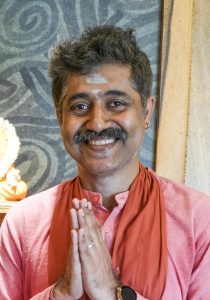
On the auspicious first day of Karthika month (mid-November), a guruswami or an Ayyappa Temple priest adorns each devotee with a purified and blessed mala made of rudraksha or tulsi beads. This signifies the start of the vrata. Those who cannot find a guruswami or temple priest can wear the mala with the help of their parents. After the mala is put on, one is considered to be the Lord Himself. Thereafter, men are referred to as “swami” and women as “malikaipuram.” First-time swamis are referred to as “kanni” swamis. These honorary titles are a constant reminder of the underlying divinity within us all.
Rules to Be Followed
The 41-day penance, said to have been decreed by by Lord Ayyappa Himself, is called a mandala. During this period, the swami must bathe twice a day in cold water, before sunrise and sunset, followed by performing a puja. Practicing ahimsa (nonviolence) and brahmacharya (celibacy) is also supremely important. The mandala involves vegetarianism and abstinence from alcohol and smoking, shaving or getting a haircut. One cannot wear footwear and must sleep only on the floor. It’s also vital to practice annadhanam—giving of food—and participate in group bhajans. Such renunciation of lavish comforts teaches one to be humble and not tied to the needs of the body, mind or emotion.
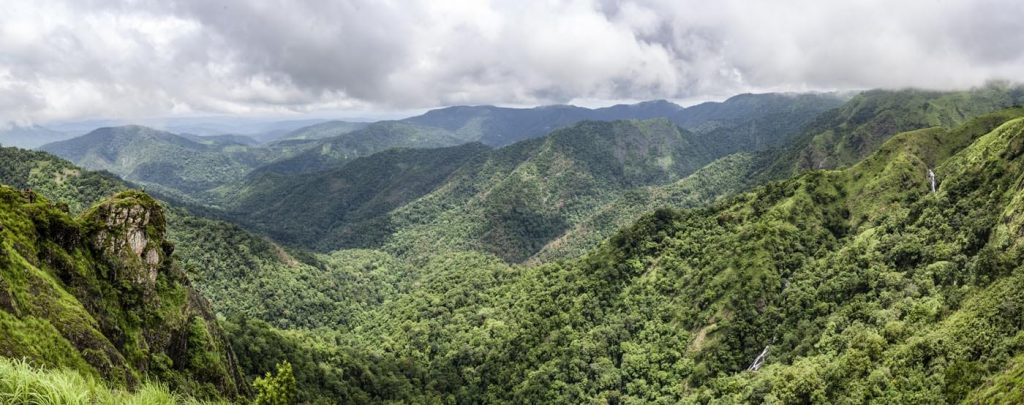
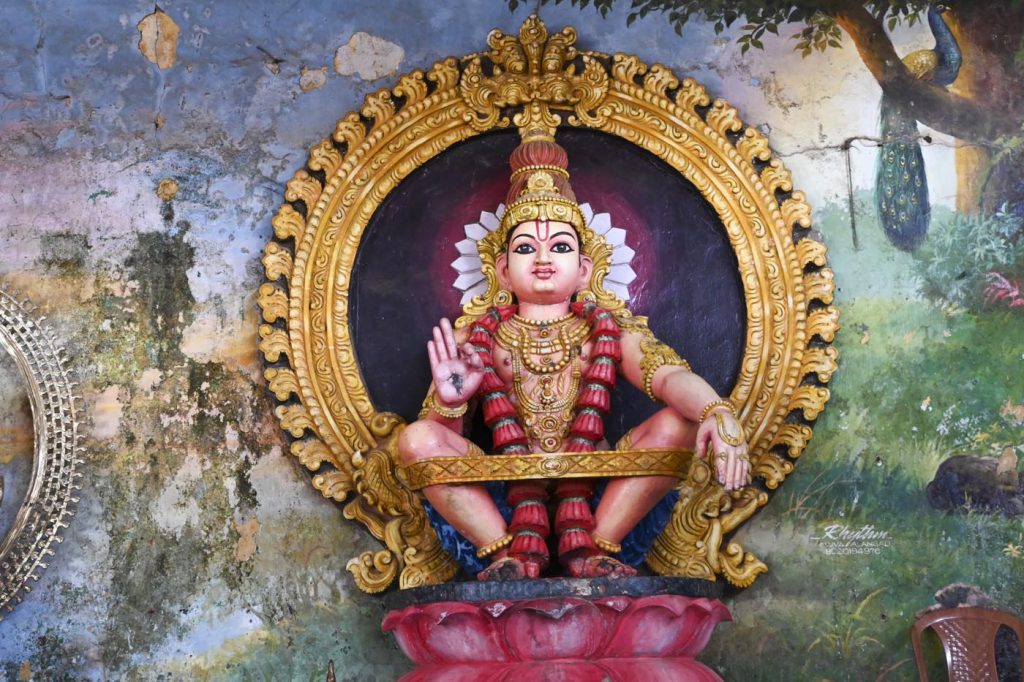
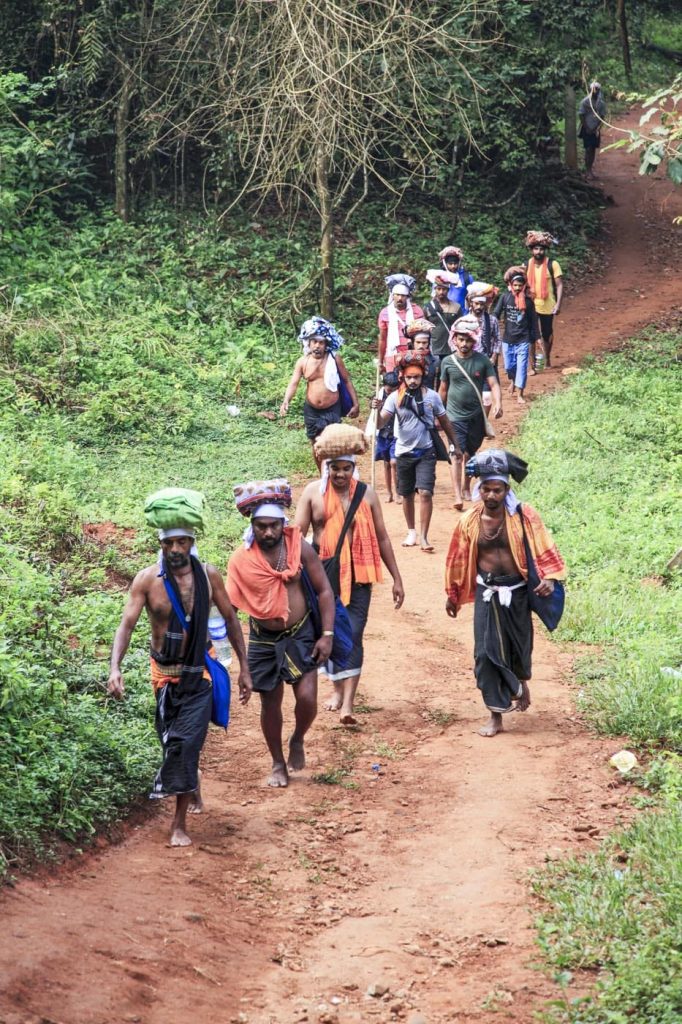
How I Began My First Pilgrimage
Long ago, my mother prayed that at least one person from the family would make a pilgrimage to Sabarimala. I was the one. My first time was during my final year in college. I began by wearing a mala, starting my penance, at the Coimbatore Ayyappa temple.
It was not easy to follow the penance in the college living quarters, with so many restrictions. However, getting up at 4am, taking a bath in cold water and walking barefoot to class, none of which I had done before, gave me a feeling of freedom from my earthly limitations. I felt I was expanding. For any college student, the Sabarimala penance will surely give the focus one needs.
Irumudi Kattu and Kettunira
Now, decades later, I had just finished the 41-day penance and we were ready to begin this year’s pilgrimage. Before we left home, we prayed to Lord Karupannaswami (a guardian Deity) to safeguard our families by breaking a coconut in front of the house. Throughout the pilgrimage coconuts are broken at different places, each signifying completion of a milestone and breaking of our egos.
We performed the sacred puja called kettunira at the starting temple. The ritual was very powerful, as hundreds of swamis chanted together at the same time; the vibrations are so strong that one forgets all material life. The puja involved a sacred process of pouring ghee inside a dried coconut with the help of a guruswami. Ghee has a special meaning in Hinduism. Milk lasts for a day, then decays. Curd, made from milk, lasts for a week and decays, and butter out of curd lasts for a month and, again, decays. But ghee, made from butter, lasts forever. The process of making ghee represents how the eternal soul evolves over many earthly experiences.

Guruswami assisted us with the puja and also in preparing our irumudi—a sacred bag carried on one’s head. We tied shut the irumudi (literally “two knots”), securing the items needed for the journey, such as vibhuti, sandal powder, kumkum, etc. The irumudi itself is said to represent the Deity.
While performing irumudi puja, family members and friends also offered their prayers and filled my irumudi bag with rice and coins. During the latter part of my pilgrimage, I learned that this process also signifies the last rites. One’s return from a pilgrimage is not guaranteed. While I was on pilgrimage, my family continued the prayer and puja at home.
Insights about Offerings
The coconut has three eyes, just like Lord Siva, and is a symbol of Him. Lord Vishnu, in His famous avatar of Lord Krishna, was a cowherd boy who loved ghee, which is a symbol of Him. The irumudi carries both coconut and ghee, signifying the unity of Siva and Vishnu as one God, the offspring of whom is Lord Ayyappa.
In another interpretation, the coconut is considered to be the body, which houses the ghee which symbolizes the eternal soul. At the temple, the coconut is burned while the ghee is offered as abhishekam to Lord Ayyappa. Thus the body is temporal, while the jivatma (soul), which is eternal and ultimately merges with the paramatma (universal soul).
I was anxious to join a random group for the pilgrimage. As mentioned earlier, devotees are guided by a guruswami. My group included swamis from all sorts of backgrounds: students, bank officers, clerks, police constables and more. However, everyone is equal on the pilgrimage. We learned to see God in each of us and love and respect everyone. The experience was powerful.
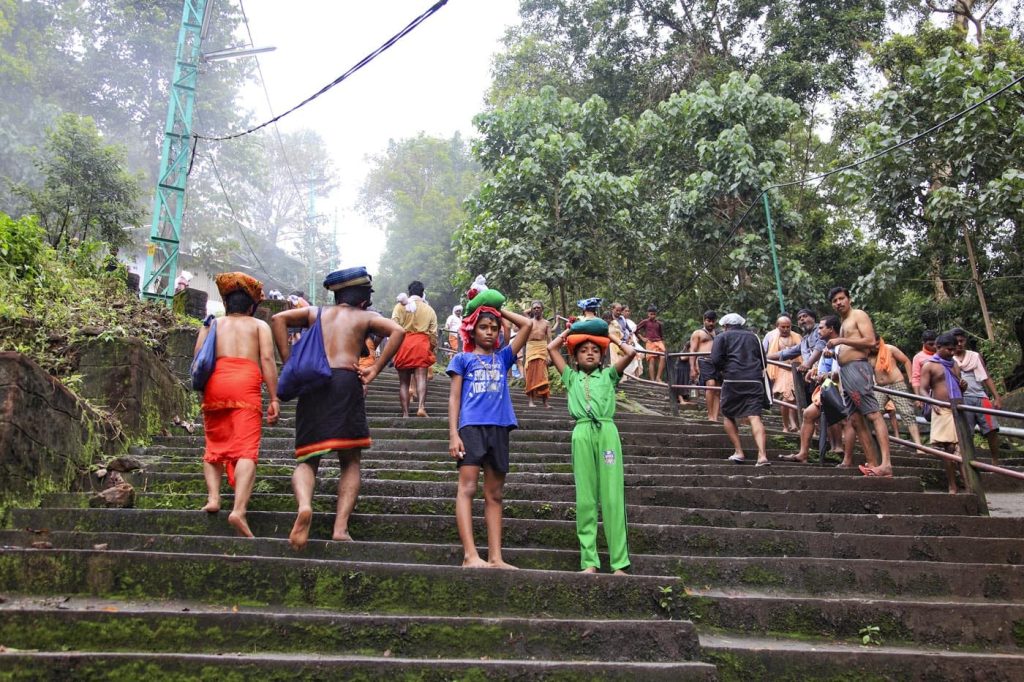
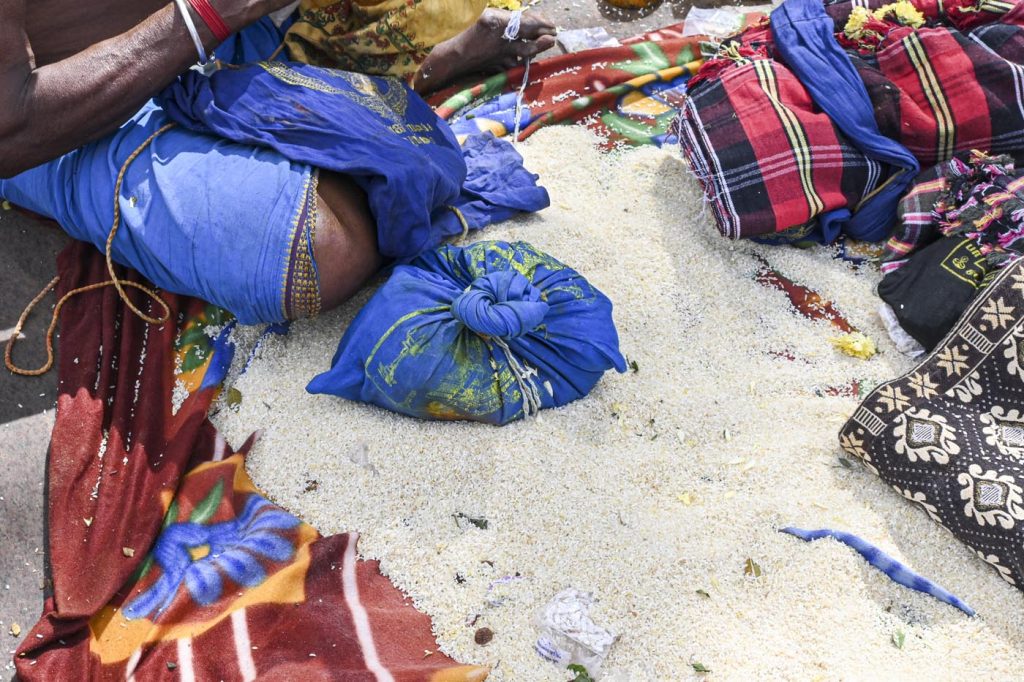
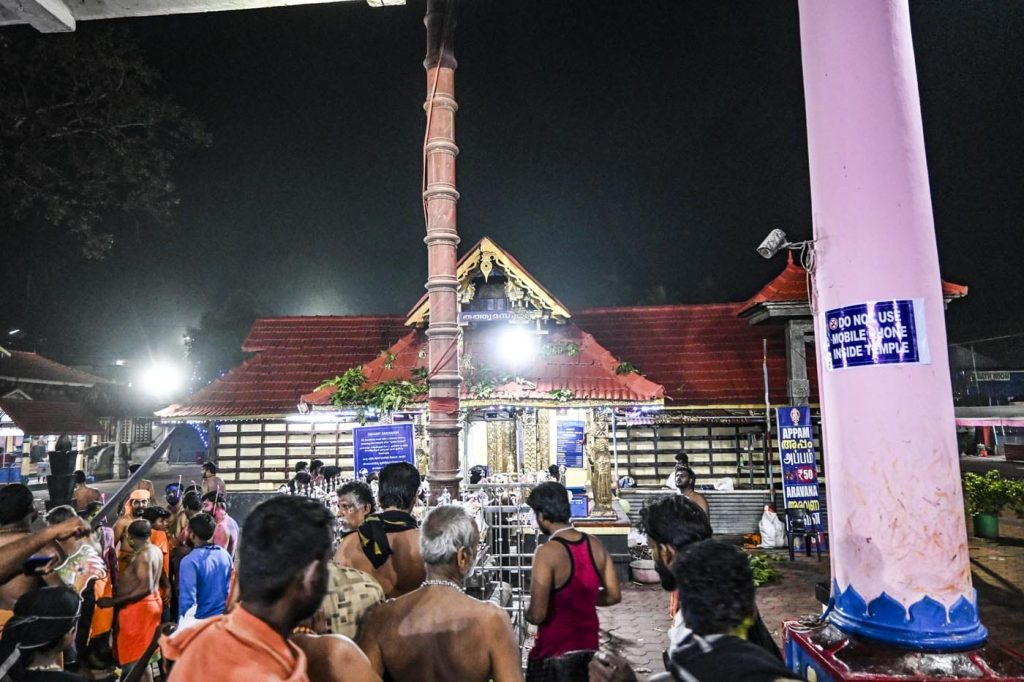
Swamis come back time and time again for pilgrimage to Sabarimala. Why? It is their unshakable faith in Lord Ayyappa. Each of their stories is inspiring. One swami, traveling with his five-year-old son who was mute and deaf, had a strong faith that Ayyappa would grace the boy to speak. A guruswami explained to me how his daughters got married with the grace of Lord Ayyappa.
Each time we stopped for food or other needs, everyone chanted zealously, “Swamiye Saranam Ayyappa,” which reinvigorated us all. I could not wait to get darshan. It seemed like every 30 minutes I asked Guruswami, “Are we there yet? How much longer will it take to reach the temple?”
First Stop: Erumeli
After almost 10 hours, we reached Erumeli, about 30 miles beyond the river Pamba. Like Lord Murugan, Lord Ayyappa has six temples: Erumeli, Sori Muthaiyan, Achankovil, Aryankavu, Kulathupuzha and Sabarimala. These correspond to six chakras: muladhara, svadhishthana, manipura, anahata, vishuddha and ajna, respectively.
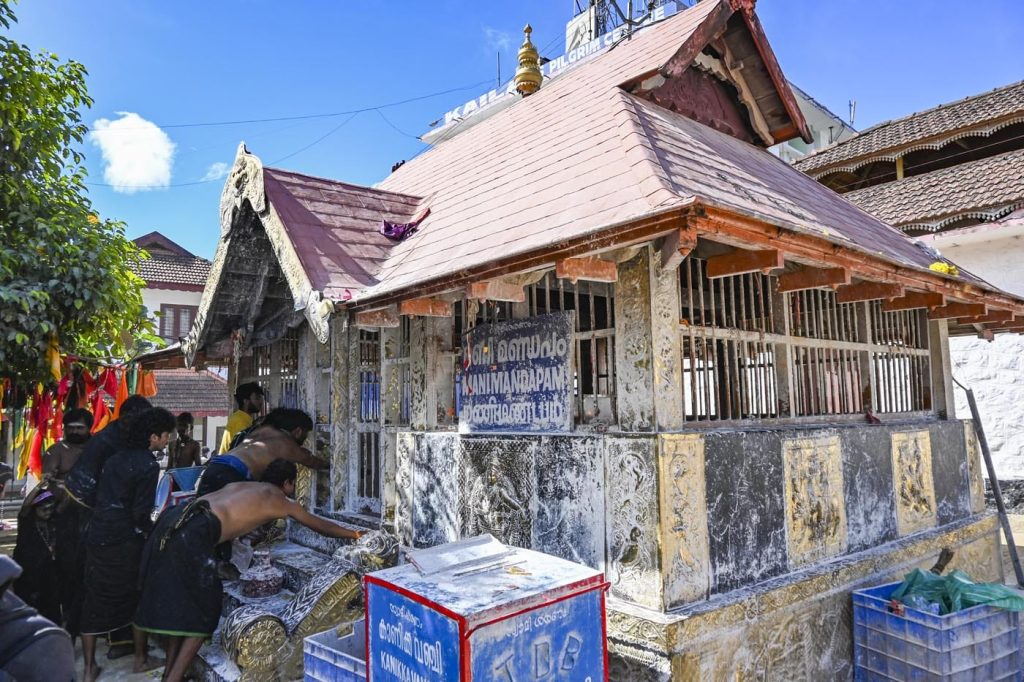
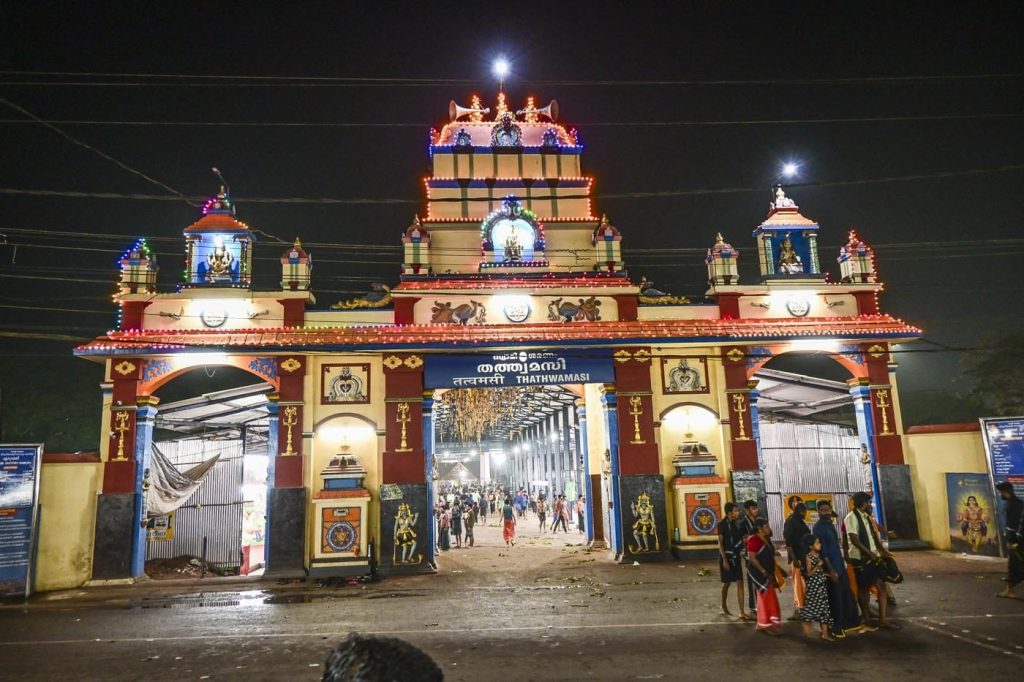
Erumeli is the site where Lord Ayyappa defeated the demoness Mahishi. At Erumeli, Lord Ayyappa graces devotees in the form of Lord Sastha. Before going for darshan, we performed a play called Pettai-Thullal. We applied colors and danced, losing our identities in the love of the Lord, simulating the victory scene of Lord Ayyappa’s win over demoness Mahishi. Then we bathed in the river and paid tribute to Lord Sastha.
A Traditional Path
Erumeli is the starting point for the traditional path. Swami groups who take this path, which is open only during Makara Jyothi, trek through five mountains. Swami groups who want to take a shorter route drive to Pamba by vehicle.
I had occasion to take the traditional path only once. To be honest, it was really hard. It took about 40 hours to trek from Erumeli to Pamba. Our guruswami never revealed the challenges involved, but just kept motivating us. Now and then, he would assure us that in another three miles we would arrive. Soon catching on to his tricks, we began focusing on Lord Ayyappa. The forest—one of India’s many tiger reserves—was very dense. Forest officers suggested we trek only in groups, since wild animals were around. The guruswami reminded us to chant “Ayyappa” to keep focused and complete the pilgrimage safely.
As we continued our journey that year, we arrived at Kaalai Katti, the location where God Siva had tied his bull, Nandi. After a brief darshan, we continued chanting “Swamiye Saranam Ayyappa” and climbed the Azhudha Hills to the holy Azhudha river. As soon as we touched the water, all the tension in our legs magically vanished. We were told to reach into the water and pick up the first stone we touched, without looking. Our guruswami told us to pray that we get a small stone, so we could carry it easily. The stones we picked represented the karma we create and carry. By taking the challenge we help resolve the karma. We carried this stone to Kallidumkundru (literally, “a place to throw the stone”), where demoness Mahishi was buried.
After another mile or so, we started to climb one of the toughest mountains, Karimalai. At certain points the mountain seems almost vertical. We crawled like babies. Luckily, we crossed this part during the night with the full moon lighting our path, not knowing what was ahead of us. Sometimes it’s helpful to face challenges only as they appear. We were thankful to enjoy annadanam—free offering of food—in appointed spots along the 25-mile stretch, providing us with much-needed energy. We halted at the Karimalai summit and the next day began climbing down. The descent was equally challenging and our legs were tired. But we just kept chanting Ayyappa’s name. After a mile or so, the welcome sounds of river water flowing down the valley reached our ears.
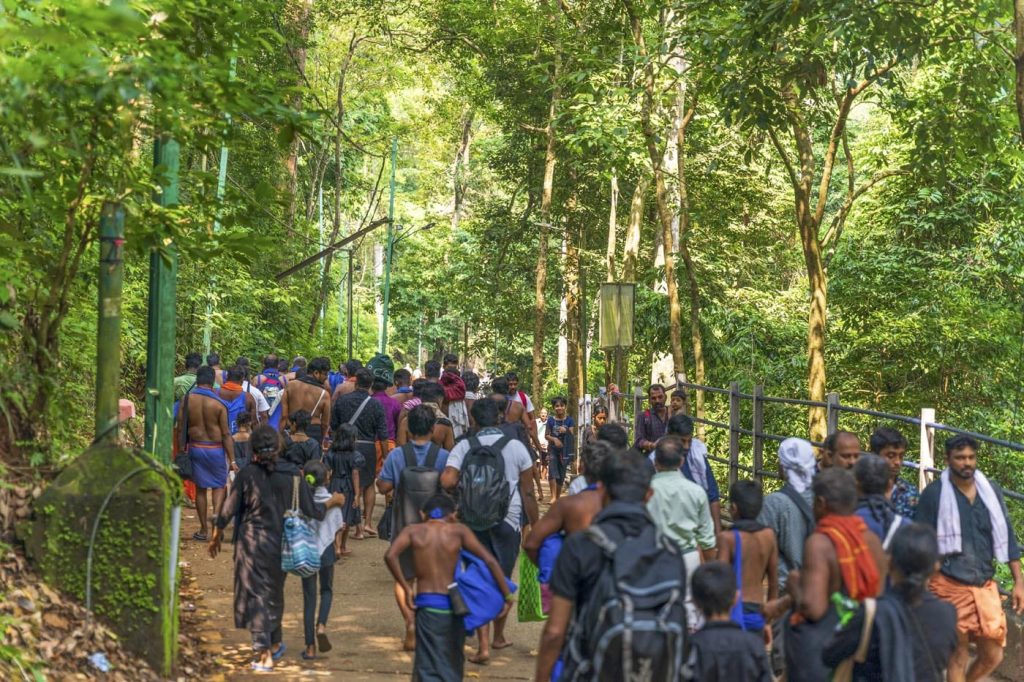
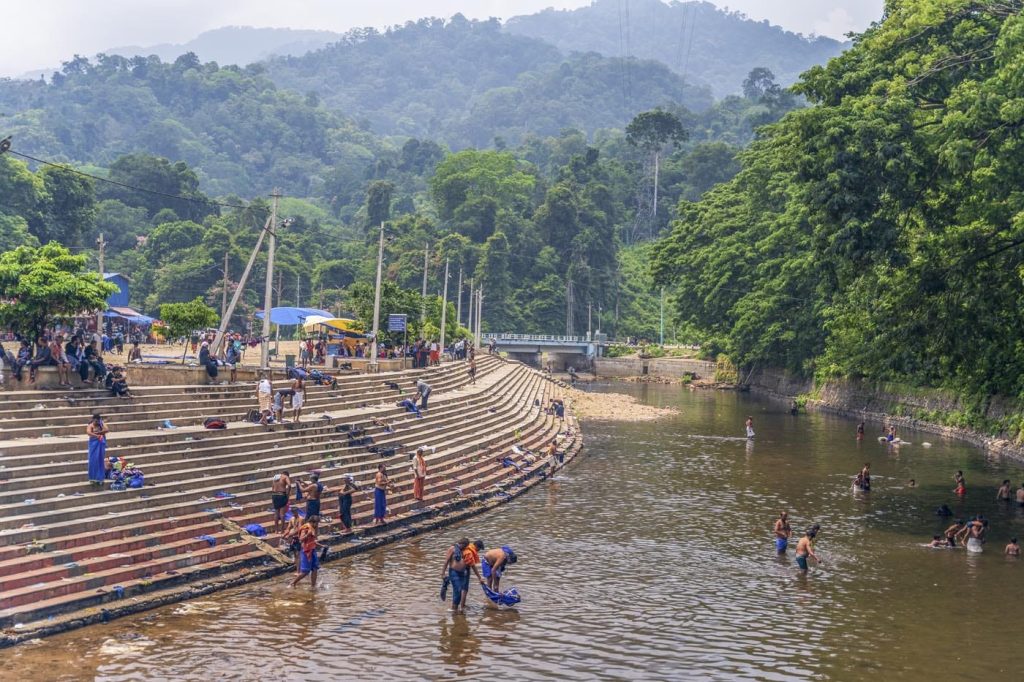
The Holy River Pamba
“Finally!” Guruswami said. We were nearing the holy river Pamba, a special place where baby Ayyappa was discovered by Pandhala Raja, a Pandya king who raised him. The infant was wearing a bell (mani) around his neck; and hence is also called Manikandan. Swamis making their third pilgrimage are referred to by this name.
Pamba is the meeting point with swamis who have taken the short path from Erumeli, a two-hour journey. On a short break at Pamba, we took a holy dip in the sacred river to purify ourselves. It is believed Pamba carries blessing equal to that of the river Ganga. The beautiful view from here is like none other. We performed puja to our irumudis and chanted the Ayyappa hymn, praying to the Lord for peaceful darshan.
Security Measures and Traffic Control
Each year nearly 40 million devotees visit Sabarimala during Makara Jyothi. Kerala’s Travancore Devaswom Board does an excellent job of managing traffic and ensuring pilgrim safety. In recent years, the board has introduced an online reservation system (sabarimalaonline.org) to manage the influx. At Pamba, the each pilgrim’s reservation is checked, and only those with a booking for the current time slot are allowed to continue. Others can remain at Pamba until their turn comes.
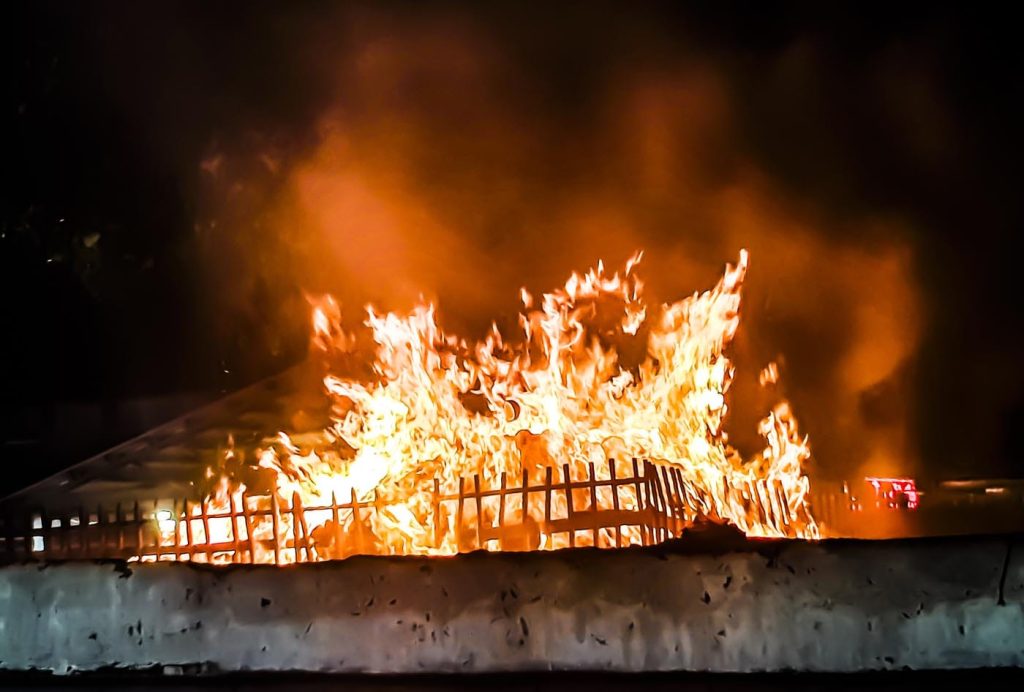
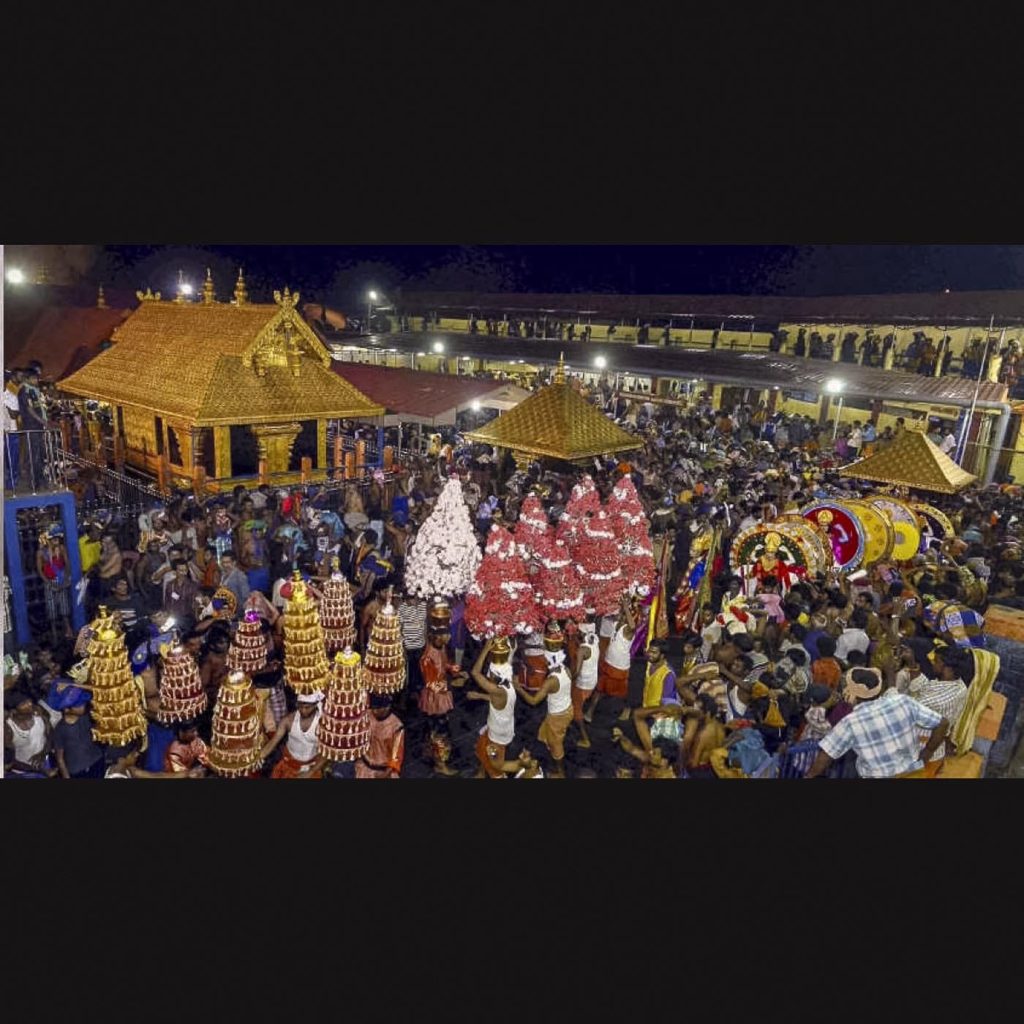
Kannimoola Ganapathi
After the security check, we began ascending the Sabari Hills. Arriving at the Kannimoola Ganapati shrine, we broke a coconut and received darshan of Lord Ganesha. The blessings given by Him are, of course, vital for a good start and the best pilgrimage overall. As we climbed the path, we encountered shrines for Lord Hanuman, Lord Rama, Naga and Goddess Devi and made humble prayers to each.
At the beginning, two paths diverge, one for pilgrims climbing toward the temple and another for pilgrims on the descent. The descending path is called the Subramaniya Path. It is also a utility road for tractors transporting materials, including food items, and by elephants on special puja days. We climbed Neelimala, then Appachimedu and Sarankuthi before finally reaching the Sannidhanam (temple complex).
Pathinettam Padi
Many of my guruswamis emphasized the holiness of the Pathinettam Padi, the 18 steps at Sabarimala Temple that lead into the sannidhanam. I was told the steps represent and contain the blessings of all the devatas from the 18 mountains around Sabarimala. They also represent the five senses, eight hindrances to spiritual life (pride, anger, etc.), the three gunas, and the twin forces of ignorance and illumination.
After ascending the wide stone stairway, we took blessings at the temple kodimaram (flagpole) and navigated through the ocean of devotees to finally get darshan from Lord Ayyappa inside the temple. Many happy tears were the norm. One may have so many challenges in life, but at the sight of that inner sanctum, all those troubles, all the hard hills, all the thorns and challenges are forgotten. We became newborns in front of Lord Ayyappa. The experience cannot be put into words. I felt mystically, purified and unburdened.
After this beautiful darshan, we made our tributes to the other Deities at the temple sannidhanam. Some devotees poured the ghee they had carries in their knapsacks the sannidhanam ghee tank as an offering. Many were buying supplies to take home from the prasadam counters—vibhuti, kumkum, turmeric and Ayyappa ghee.
We circumambulated the temple and prostrated, taking one last dive into the ocean of devotion. Then we slowly descended from the temple and looked for shelter nearby. The Devasom Board has many rooms available for pilgrims based on reservations. Often pilgrims find an available place near the temple. We took shelter at the Ayyappa Seva Sangam and unpacked the irumudi as we chanted and performed puja. We opened the ghee coconut, transferred the ghee (our atma) to a clean vessel, and gave it to the temple priest took who poured it over the Ayyappa murti during abhishekam. He then captured some of the blessed ghee from the murti, filled our vessel, and returned it to us. That is the prasadam that we had all awaited. After the abhishekam, we threw our coconut (mystically representing our body) into the fire area near the sacred 18 steps.
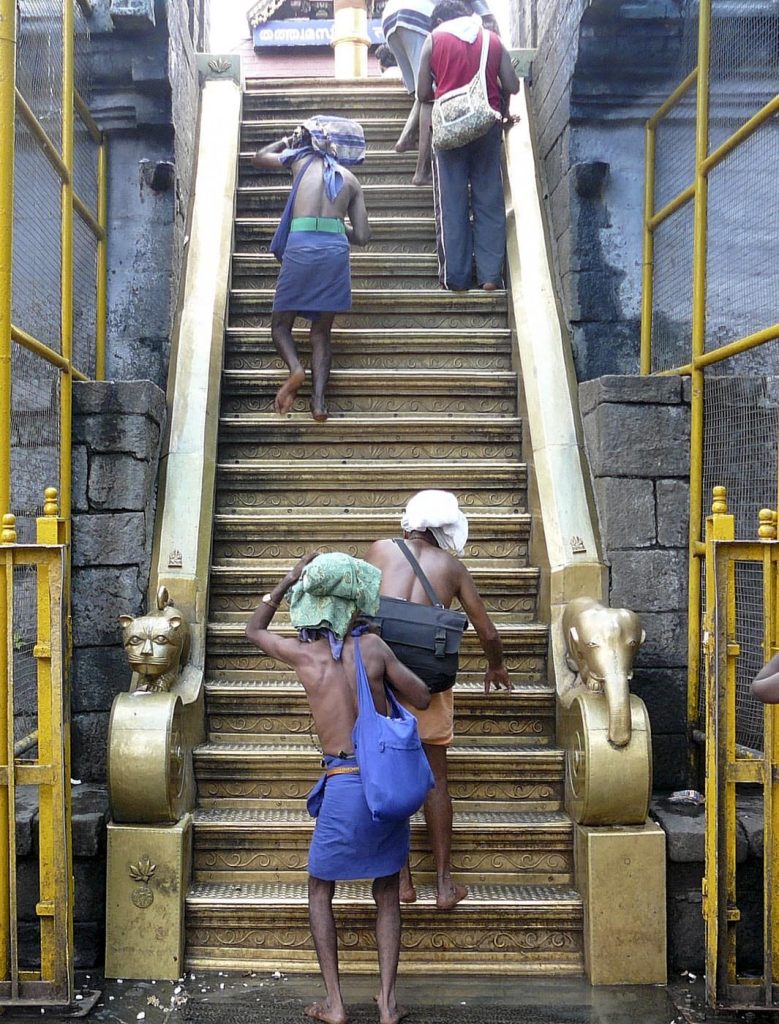
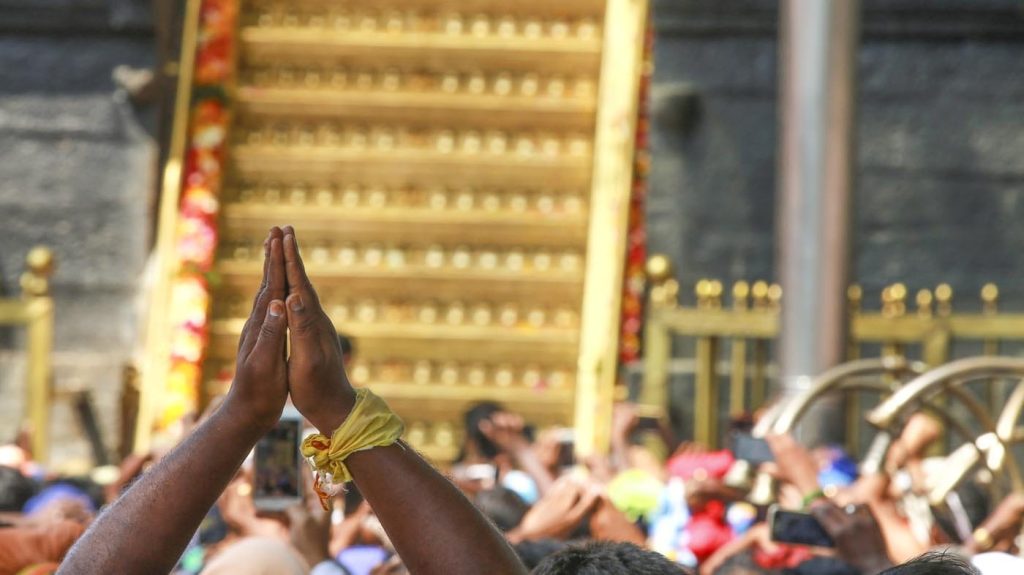
Malikappuram Devi
We then went to the Malikappuram Devi Temple to seek darshan. Malikappuram Devi, revered as Lord Ayyappa’s mother, She grants devotees the ability to blossom in their lives. It is customary for young women to have new blouse material blessed by Malikappuram Devi to resolve any issues with finding a suitable spouse.
We then proceeded for darshan at Mani-mandapam, the site of Ayyappa Jiva Samadhi, then saluted Nagadevatha, Navagraha, and every deva present.
A major highlight of my pilgrimage was angapradhikshanam, a religious vow to lie down and roll around the temple. I performed it at 1:00am, and the experience was divine. Beforehand I followed the custom of bathing in the warm waters of Bhasmakulam pond near the temple exit gate.
Programs at Sabarimala Temple
The most significant day of the annual Sabarimala pilgrimage is the festival of Makaravillakku, which culminates the pilgrimage season. A sacred fire is lit at Ponnambalamedu summit, representing the crown chakra. From Sabarimala Temple, four kilometers away, devotees witness the fire as Lord Ayyappa in His form of light. Devotees believe they attain the sahasrara chakra within themselves by witnessing this holy Makara Jyothi. On this the special day, Lord Ayyappa dons the golden jewelry that belonged to King Pandalam and offers darshan in the role of “Rajathi Raja” (king).
Sabarimala Temple is only open for pilgrimage for two months a year, from mid-November to mid-January. Makaravillaku is celebrated in mid January (usually the 14th), as the sun enters Capricorn and the Pongal or Sankranti festival is observed in many parts of India.
Providing Annadhanam
No Sabarimala pilgrimage ends without enjoying annadhanam at ABAAS (akhilabharathaayyappasevasangam-tn.org), a 75-year-old nonprofit organization whose devotional service provides 24/7 free food and medical service at various spots from Erumeli to Sabarimala. They also provide stretcher service for any kind of medical help across the 30-mile route. Organization member Mr. K. Aiyappan mentioned, “The volunteers’ joy of selfless service together with the pure Ayyappa bhakti is the reason for providing such a noble service to all devotees at this scale.”
Pure Devotion
Each of my pilgrimages has been like a small reincarnation for me, advancing my soul to its next stage of evolution. When I started my first pilgrimage, I did not think I would ever be completing it a full 18 times. Each one has provided me and those around me with new mystical and positive experiences. The Ayyappa penance is not intended to be followed only during one season of the year; it is intended to be the way one must live every day.
The significance of having a guru in one’s life is really something I acquired through the Sabarimala pilgrimage. Gurus who have already traveled the spiritual path can guide the shishya in the proper direction to complete their inner journey.
All the past is burned in the large fire there, reminding me to live in the present, and to follow dharma, nonviolence, and a vegetarian diet—respecting every soul and honoring Mother Earth. The Sabarimala pilgrimage taught me how to live with the bare minimum of things in life, to be simple and healthy. More importantly, I acquired the ability to focus on one goal, Lord Ayyappa, every moment. It helped me subconsciously to focus on any other goal, which, with preparation and the grace of the Lord, can now be achieved with less effort. Along the way, I was able to inspire many to join the Sabarimala pilgrimage, and Lord Ayyappa has brought many wonders into their lives as well.

Thank you, Madan Ganesan, for your accurate and inspiring article about Lord Ayyappan and your 18 pilgrimages to Sabarimala. The photos are also excellent. I went to Sabarimala with my Guruswamy two times when I was 60 years old. I lived in India for about two years. I am back in Kalamazoo, Michigan, now. Kindly go to my website and you tube channel and hear some of the songs that Lord Ayyappan gave to me years ago. Or let me mail you a copy of the songbook. It is in English, Kannada and Tamil, depending on the song. I love meeting Ayyappan devotees. We are all part of his great spiritual family. He is made of love, pure love. I also wrote a biography about my Guruswamy when I returned to Michigan. It is on Amazon, entitled Driven by the Divine. One of the chapters is devoted to my discovery of Dharma Shasta Lord Ayyappan. He is made of light and bliss. You know that. I know that.
Thanks again for the great article. You are a fine writer 🙂
A well written detailed blog on Sabarimala Pigrimage.
Very nicely written. I can see your emotions pour through. Thanks for sharing.
Pingback: Divine Dance: Lord Ayyappa - Iraivan.ME